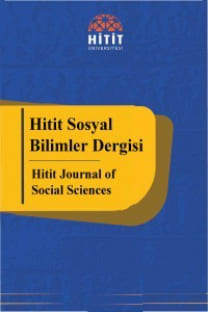“ŞAİRLER MENBAI” VARDAR YENİCESİ VE VARDAR YENİCELİ ÜÇ ŞAİR: HAYRETÎ - USÛLÎ - HAYÂLÎ*
Osmanlı döneminde Selanik vilayetine bağlı olan Vardar Yenicesi (Yenice-iVardar), bugün Giannitsa/Yannitsa adıyla Yunanistan sınırları içinde yeralmaktadır. I. Murat döneminde Evrenos Bey tarafından fethedilen VardarYenicesi, Türklerin iskânı ile kısa sürede bir kültür merkezi hâlini aldı. KlasikTürk edebiyatının temel kaynakları olan tezkireler incelendiğinde VardarYenicesi’nin birçok büyük yerleşim biriminden daha fazla şair yetiştirdiğigörülmektedir. Osmanlı Devleti’nin kültür merkezi olan İstanbul’dan uzakolmasına rağmen “şairler menbaı” olmasında, buradaki tasavvufi ortamın etkisibüyüktür. Akıncı beylerinden Evrenosoğulları’nın himayesinde olan VardarYenicesi, yapılan cami, medrese, külliye ve hanlar ile mamur hâle getirilirkenşehrin manevi yapısı Evrenosoğlu Ahmet Bey’in davetiyle buraya gelenMolla İlâhî ile tamamlanmıştır. Molla İlâhî, vahdet-i vücuda dayalı tasavvufidüşüncenin bu bölgede yayılmasını sağlamış ve bu ortamdan etkilenenHayâlî, Hayretî, Usûlî, Sırrî, Günâhî, Âgehî, Yûsuf-ı Sîne-çâk gibi pek çok şairyetişmiştir. Şairlerin ortak özellikleri; samimi bir söyleyiş, baş eğmez tutum,dünyaya kayıtsız bir yaşam tarzıdır. Bu çalışmada, bir kültür merkezi olarakVardar Yenicesi, burada yetişen önemli şairlerden Hayretî, Usûlî ve Hayâlî’ninbağlı oldukları tasavvufi sistem ve bunun şiirlerine yansıması incelenecektir.
Anahtar Kelimeler:
Vardar Yenicesi, Hayretî, Usûlî, Hayâlî, Molla İlâhî, Giannitsa/Yannitsa
“Source of the Poets” Vardar Yenicesi and Three Poets from Vardar Yenicesi: Hayretî - Usûlî - Hayâlî
Vardar Yenicesi (Yenice-i Vardar) which was connected to the provinceof Thessaloniki during the Ottoman Period, is today located within the bordersof Greece and named by Giannitsa/ Yannitsa. Vardar Yenicesi was conqueredby Evrenos Bey during the period of Murat the Ist, and shortly thereafterbecame a center of Ottoman culture as a reult of the settlement of Turkishspeaking people. When tezkires, which are the main sources of classicalTurkish literature, are examined, it can be found that Vardar Yenicesi trainedmore poets than many large settlements. Despite Vardar Yenicesi being a longdistance away from İstanbul, the city which was the cultural center of theOttoman Empire, it is the source of the poets and the reason for this is theinfluence of its mystical atmosphere. Vardar Yenicesi, which was under theauspices of Evrenesoğulları, was turned into a prosperous city as the result ofa mosque, a madrasas, numerous precincts and hans being built. The spiritualstructure of the city was completed by Molla İlâhî, who went to the city at theinvitation of Evrenosoğlu Ahmet Bey. Molla İlâhî provided the understandingthat mystical ideas (which were based on vahdet-i vücut) spread in this regionand that environment helped train more poets like Hayâlî, Hayretî, Usûlî, Sırrî,Günâhî, Âgehî, Yûsuf-ı Sîne-çâk who were affected by it. These poets all sharedcertain characteristics: a sincere way of speaking, an indomitable attitude,and a way of life that was oblivious to the rest of the world. In this study,Vardar Yenicesi is evaluated as a cultural center, and also Hayretî and Usûlîve Hayâlî, who are important poets that grew up there, are evaluated in theview of the mystical system they are connected to. In addition, a reflection onthe effect that this mystical system had on their poems will also be examined.
Keywords:
Vardar Yenicesi, Hayretî, Usûlî, Hayâlî, Molla İlâhî, Giannitsa/Yannitsa,
___
- ÇAVUŞOĞLU, Mehmed. (1974), “Hayretî’nin Belgrad Şehr-engîzi”, Güney-doğu Avrupa Araştırmaları Dergisi, S. 2-3, ss. 325-356.
- ___. (1976), “Hayretî’nin Yenice Şehr-engîzi”, Güney-doğu Avrupa Araştırmaları Dergisi, S. 4-5, ss. 81-100.
- ÇAVUŞOĞLU, Mehmed ve TANYERİ, M. Ali (hzl.). (1981), Hayretî-Dîvan, İstanbul Üniversitesi Edebiyat Fakültesi Yayınları, İstanbul.
- DEMİR, Hiclâl. (2001), Çağlarını Eleştiren Divan Şairleri: Hayretî-Usûlî-Hayâlî, Bilkent Üniversitesi Ekonomi ve Sosyal Bilimler Enstitüsü Yayımlanmamış Yüksek Lisans Tezi, Ankara.
- GÖLPINARLI, Abdülbâki. (1953), Nesimi-Usuli-Ruhi-i Bağdadi, Varlık Yayınları, İstanbul.
- İSEN, Mustafa (hzl.). (1990), Usûlî Divanı, Akçağ Yayınları, Ankara.
- ___. (hzl.). (1994), Künhü’l-Ahbâr’ın Tezkire Kısmı, AKMY, Ankara.
- ___. (1997), “Tezkirelerin Işığında Divan Edebiyatına Bakışlar - Osmanlı Kültür Coğrafyasına Bakış”, Ötelerden Bir Ses, Akçağ Yayınları, Ankara, ss. 64- 75.
- ___. (1997), “Kültür Tarihimizden Portreler: Usûlî”, Ötelerden Bir Ses, Akçağ Yayınları, Ankara, ss. 267-271.
- ___. (1998), “Akıncılığın Türk Kültür ve Edebiyatına Katkıları”, Türkiye Günlüğü, S. 49, ss. 80-86.
- ___. (hzl.). (1999), Latîfî Tezkiresi, Akçağ Yayınları, Ankara. KARA, Mustafa (1988), “Molla İlâhî’ye Dair”, Osmanlı Araştırmaları, S. VII-VIII, ss. 365-390.
- KILIÇ, Filiz (hzl.). (1994), Meşa’irü’ş-Şu’ara I-II, Gazi Üniversitesi Sosyal Bilimler Enstitüsü Yayımlanmamış Doktora Tezi, Ankara.
- KIEL, M. (1971), Yenice-i Vardar (Vardar Yenicesi-Giannitsa) A Forgotten Turkish Cultural Centre in Macedonia of the 15th and 16th Century, Studia Byzantina et Neohellenica Neerlandica III, Leiden.
- ÖZCAN, Abdülkadir. (1989), “Akıncı”, TDV İslam Ansiklopedisi, C. 2, ss. 249-250.
- ÖZMEN, İsmail. (1998), Alevi-Bektaşi Şiirleri Antolojisi, C. 2, KBY, Ankara.
- TARLAN, Ali Nihat (hzl.). (1992), Hayâlî Divanı, Akçağ Yayınları, Ankara.
- Yayın Aralığı: Yılda 2 Sayı
- Başlangıç: 2008
- Yayıncı: Hitit Üniversitesi
Sayıdaki Diğer Makaleler
BİLİMSEL YÖNTEM TARTIŞMALARI III
Yrd. Doç. Dr. Zülfikâr BAYRAKTAR
WAS THE INDIAN MUTINY CONSEQUENCE OF THE BREAKDOWN OF THE BRITISH INFORMATION SYSTEM?
Küresel Dünyada Göç Kültürel Etkileşim ve Çokkültürlülük
ÇEVRE EKONOMİSİNDE ÇEVRE VERGİLERİ UYGULAMALARI
“ŞAİRLER MENBAI” VARDAR YENİCESİ VE VARDAR YENİCELİ ÜÇ ŞAİR: HAYRETÎ - USÛLÎ - HAYÂLÎ*
Sosyal Bilimler Mantığı ve Kelâm
ALEVİ SÜNNİ BÜTÜNLEŞMESİNİN ÖNÜNDEKİ ENGELLER: TARİHSEL YANLIŞ ALGILAMALAR*
KÜLTÜREL DEĞİŞİMİN TÜRK TELEVİZYON REKLAMLARINDAKİ KADIN İMAJINA ETKİSİ
Yrd. Doç. Dr. Nuriye BÜYÜKKAYACI DUMAN, Arş. Gör.gülay YILMAZEL, Arş. Gör. Burcu AKBULUT BAŞCI
